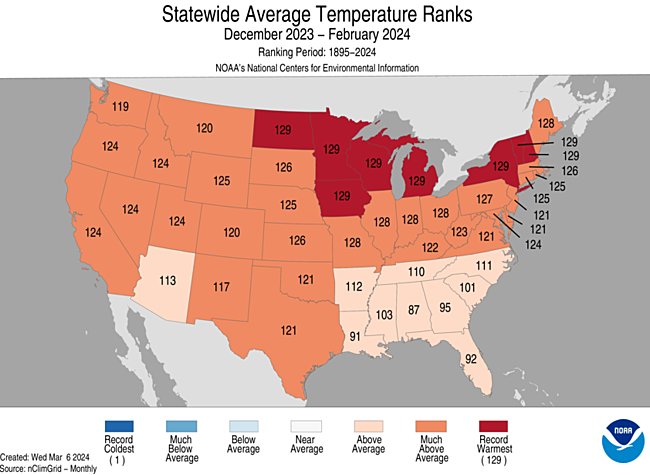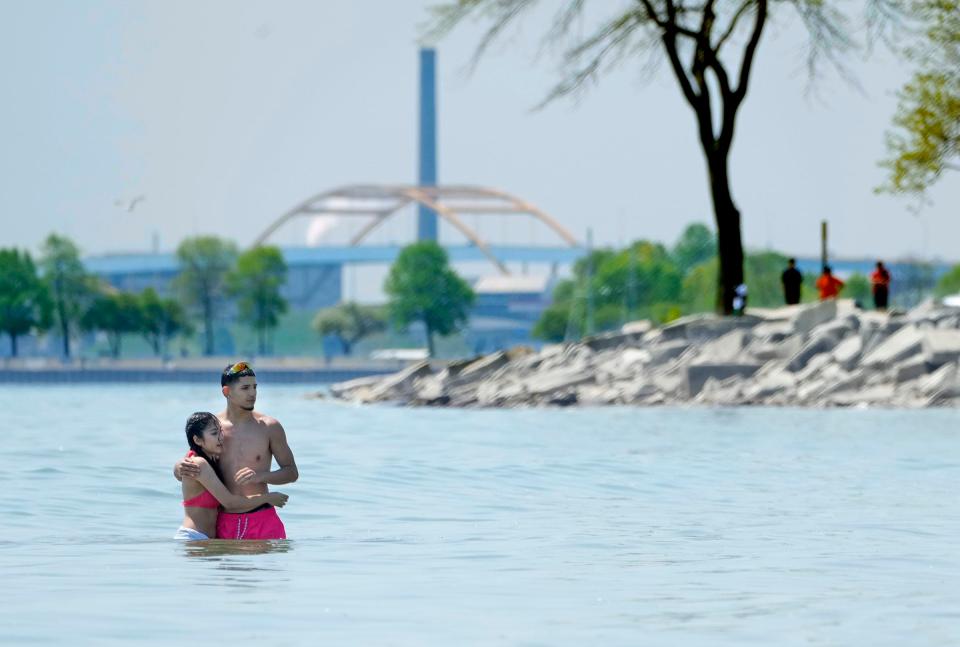2023-24 really was Wisconsin's warmest-ever winter, state climatologist confirms
Last week, weather experts confirmed what many have been predicting for the past few weeks ― this was in fact Wisconsin's warmest-ever winter on record.
The Wisconsin State Climatology Office announced Friday that December 2023-February 2024 was the warmest winter in the state since record-keeping began in 1895.
This winter was nearly 10 degrees warmer than Wisconsin's three-month winter normal of 18.5 degrees. The three-month average temperature across the state was 28.3 degrees, more than two degrees warmer than Wisconsin's previous warmest-ever winter in 2001-2002, which saw a three-month average of 26.1 degrees.
This past winter has been declared Wisconsin’s warmest since record-keeping began in 1895. This 3-month statewide average temperature was 28.3°F, which is 9.8°F above normal (the 1991-2020 normal is 18.5°F). pic.twitter.com/JXr1aqrIcU
— Wisconsin State Climatology Office (@WI_ClimateSCO) March 8, 2024
Numerous smaller weather records were set during this record-setting winter.
December 2023 was Wisconsin's warmest last month of the year on record. It was the first time the statewide average December temp was above freezing (the month's average was 32.3 degrees), and the month was only about two degrees colder than November.
Thanks to nine days of well-below-normal temperatures during mid-January's cold snap, the first month of the year was only Wisconsin's 10th warmest on the books. Still, this January was 8.5 degrees warmer than normal, on average.
This February was also Wisconsin's warmest ever. The statewide average temp was 31.8 degrees, according to state climatologist Steve Vavrus. This is more than 16 degrees above the average February temperature. Wisconsin's previous warmest-ever February occurred in 1998 with a statewide average temp of 31.6, WKOW 27 reported.

This was also the warmest winter in history in the U.S.
"This was a historically warm winter, not only in Wisconsin but in most of the northern half of the country," Vavrus said.
Iowa, Minnesota, Michigan, North Dakota, New York, New Hampshire and Vermont also saw their warmest winters on record. Five additional states recorded their second-warmest winters.
Furthermore, the contiguous United States experienced its warmest-ever winter, according to the National Oceanic and Atmospheric Administration. The country recorded a three-month average temp of 37.6 degrees, more than five degrees above average.

This season's winter weather records include Wisconsin's first February tornado and a 60-degree temperature drop
This winter's unseasonably warm weather set the stage for other notable weather records throughout the state.
These included Wisconsin's first-ever and only February tornado, which touched down near Edgerton and Evansville on Feb. 8. The tornado spun up, in part, due to record-setting warm temperatures. Usually, cold weather prevents winter tornadoes from happening in Wisconsin. The Feb. 8 tornado was one of only five winter tornadoes in the state's recent history.
Interestingly, the National Weather Service issued more tornado and thunderstorm warnings than winter storm warnings and other winter weather advisories in Wisconsin this winter. Five tornado warnings, eight severe thunderstorm warnings and six winter weather advisories were issued this season. NWS did not issue any thunderstorm or tornado warnings in Wisconsin last winter.
Wisconsin also recorded its highest February and highest winter temperature of all time ― 77 degrees in Kenosha on Feb. 27, Vavrus said. This shattered the previous February and winter record by five degrees.
This was quickly followed by a record-setting temperature drop across the state, with temps plummeting 60 degrees in some areas overnight. In Milwaukee, temps tanked from 74 degrees on the afternoon of Feb. 27 to just 16 degrees the following morning.

Why was this Wisconsin's warmest-ever winter?
"The extreme warmth this winter was likely caused by a combination of the El Ni?o event in the Pacific Ocean and the long-term climatic warming trend," Vavrus explained.
An El Ni?o event is caused when sea surface temperatures in the central and eastern Pacific Ocean warm to above average for several months. During an El Ni?o, the polar jet stream is shifted northward, which limits how far south cold-air intrusions from Canada can travel into Wisconsin.
In general, El Ni?o brings above-average temperatures to the northern United States, which often result in below-average snowfall in moderate-to-strong El Ni?o years. Last year, the Milwaukee-area NWS said this winter's El Ni?o was on track to be one of the strongest on record.
But what about climate change?
Climatology is the study of weather over time, local NWS meteorologist Taylor Patterson said. So, when it comes to whether a singular event like this season's El Ni?o was caused by climate change, it's hard to say right away.
When studying climate change, "you look at multiple events over a year or longer," Patterson said. So, regarding the cause of El Ni?o and this season's incredibly warm winter, "We don't really know, but it's definitely something that we'll be looking back on as we start to look at it in context to previous years and into the future" when studying the climate.

How will Wisconsin's warmest winter on record affect the spring and summer?
Wisconsin is expected to see the "tail end" of the El Ni?o effect in March, April and May, said local NWS meteorologist Jaclyn Anderson. While exact temps are unknown, this three-month period has a "higher potential for seeing above-normal temperatures" throughout the state.
"The impacts we get from El Ni?o during the winter will loosen their grip in the summer," Anderson said. "There's not a strong correlation between El Ni?o and what happens in the summertime."
While the Climate Prediction Center expects El Ni?o to become more neutral in the summer months, it also says there are "increasing odds" of a La Ni?a effect developing next winter.
La Ni?a allows more Arctic air to make its way down to the Midwest, Anderson said, and can cause the opposite effects of El Ni?o ― meaning we could see a colder, snowier winter in 2025.
More: Milwaukee will see high temperatures near 70 early this week, National Weather Service says
More: Winter businesses may be eligible for disaster relief loans
Journal Sentinel reporter Alex Groth contributed to this report.
This article originally appeared on Milwaukee Journal Sentinel: Winter 2023-24 was Wisconsin's warmest winter ever thanks to El Nino
